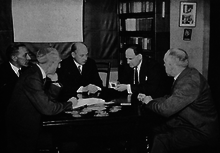Frederick Marion
| Frederick Marion | |
|---|---|
 | |
| Born |
October 15, 1892 Prague, Czechoslovakia |
| Occupation | Mentalist, psychic |
Frederick Marion (born October 15, 1892) was the stage name of Josef Kraus a mentalist and performer who claimed powers of clairvoyance and telepathy.[1][2] He was investigated by psychical researchers who attributed his abilities to detecting subtle visual clues from his audience.[2]
Career
Marion was born in Prague, Czechoslovakia. As a young man he had studied the feats of magic and became a talented mentalist performing throughout Europe.[1] He stated that he could perform the same feats as the mentalist Eugene de Rubini such as locating hidden objects.[3] Marion served in the Austrian Army during World War I. In 1920 he became friends with the clairvoyant charlatan Erik Jan Hanussen.[3]
Marion became well known for his ability to locate hidden objects. This was similar to muscle readers such as Washington Irving Bishop, however he did not need physical contact with his audience.[2] Unlike other mentalists of his era such as The Piddingtons, he claimed genuine psychic abilities.[4]
Investigations

Marion was investigated by members of the Society for Psychical Research in the late 1930-1940s. He was tested by the parapsychologist Samuel Soal at the National Laboratory of Psychical Research in a series of experiments who attributed his success not to paranormal power but to the expert ability of picking up subtle visual clues from his audience. Soal also claimed that members of The Magic Circle were able to duplicate Marion's feat of identifying playing cards.[2] Psychologist Andrew Neher has written that "Marion could identify which of a number of small cans contained an object; he did this by noting the involuntary reactions of observers who knew which can the object was in."[5]
He was investigated by Harry Price who concluded his abilities were the result of hyperesthesia, not the paranormal.[2]
Marion was tested by the psychical researchers R. H. Thouless and B. P. Weisner who rejected Soal's conclusions. From their experiments they claimed to be convinced that he possessed psychic powers. Their views were summarized in the foreword to Marion's autobiography In My Mind's Eye (1950).[2]
Magician Milbourne Christopher once worked with Marion at one of his performances and observed his methods. Christopher had no reason to believe he had genuine psychic powers. He wrote that Marion was an expert mentalist who could pick up clues from his audience's "changes in breathing, tensions and relaxations, and varying positions of the fingers, hands of the fingers, hands, and feet of his subject when he works without contact."[6]
Publications
- In My Mind's Eye (1950)
References
- 1 2 Anderson, Rodger. (2006). Psychics, Sensitives and Somnambules: A Biographical Dictionary with Bibliographies. McFarland & Company. p. 111. ISBN 0-7864-2770-1
- 1 2 3 4 5 6 Lamont, Peter. (2013). Extraordinary Beliefs: A Historical Approach to a Psychological Problem. Cambridge University Press. pp. 225-228. ISBN 978-1-107-01933-1
- 1 2 Shepard, Leslie. (1982) Encyclopedia of Occultism & Parapsychology. Gale Research Company. p. 72
- ↑ Thouless, Robert Henry. (1963). Experimental Psychical Research. Penguin Books. p. 62
- ↑ Neher, Andrew. (2011). Paranormal and Transcendental Experience: A Psychological Examination. Dover Publications. p. 33. ISBN 0-486-26167-0
- ↑ Christopher, Milbourne. (1971). ESP, Seers & Psychics. Crowell. pp. 76-77. ISBN 978-0-690-26815-7
Further reading
- Soal, Samuel. (1950). Experiments on Frederick Marion. Journal of the Society for Psychical Research 35: 251-252.
- Soal, Samuel. (1950). In My Mind's Eye. By Frederick Marion. Journal of the Society for Psychical Research 35: 187-195.
- Thouless, Robert Henry. (1950). Experiments on Frederick Marion. Journal of the Society for Psychical Research 35: 220-222.
- Thouless, Robert Henry. (1972). From Anecdote to Experiment in Psychical Research. Routledge & Kegan Paul Books.